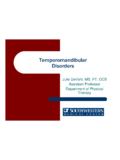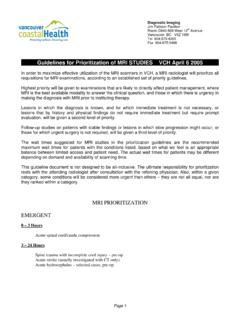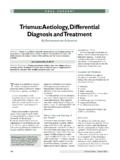Transcription of Effect of Occlusal Splints on the Stress Distribution on ...
1 Conservative approach, including Occlusal splint therapy, is the first option to treat temporomandibular disorders (TMD), because of its reversibility. The present study analyzed the Effect of the articular disc position and Occlusal Splints use on the Stress Distribution on this disc. A two-dimensional (2D) finite element (FE) model of the temporomandibular joint with the articular disc at its physiologic position was constructed based on cone-beam computed tomography. Three other FE models were created changing the disc position, according to Occlusal splint use and anterior disc displacement condition. Structural Stress Distribution analysis was performed using Marc-Mentat package. The equivalent von Mises Stress was used to compare the study factor. Higher Stress concentration was observed on the intermediate to anterior zone of the disc, with maximum values over 2 MPa. No relevant difference was verified on the Stress Distribution and magnitude comparing disc positions and Occlusal splint use.
2 However, there was Stress reduction arising from the use of the Occlusal Splints in cases of anterior disc displacement. In conclusion, based on the generated FE models and established boundary conditions, the Stress increased at the intermediate zone of the TMJ disc during physiological mandible closure. The Stress magnitude was similar in all tested situationsEffect of Occlusal Splints on the Stress Distribution on the temporomandibular Joint DiscFabiane Maria Ferreira1,2, Paulo C zar Simamoto-J nior1, Carlos Jos Soares3, Ant nio Manuel de Amaral Monteiro Ramos4, Alfredo J lio Fernandes-Neto11 Department of Occlusion, Dental School, UFU - Universidade Federal de Uberl ndia, Uberl ndia, MG, Brazil2 Department of Oral Rehabilitation, Dental School, University of Rio Verde, Rio verde, GO, Brazil3 Department of Operative Dentistry, UFU - Universidade Federal de Uberl ndia, Uberl ndia, MG, Brazil4 Department of Mechanical Engineering, Biomechanics Research Group, Universidade de Aveiro, Aveiro, PortugalCorrespondence: Paulo C zar Simamoto J nior, Av.
3 Par , 1720, Bloco 4LA, Sala 4LA32, Umuarama, 38400-902 Uberl ndia, MG, Brasil. Tel: +55-34-3225-8105. e-mail: Words: temporomandibular joint, temporomandibular joint disc, Occlusal Splints , finite element 0103-6440 Brazilian Dental Journal (2017) 28(3): 324-329 , between the condyle and the articular fossa of the temporomandibular joint (TMJ) there is the articular disc, a fibrocartilage that facilitates movement between the mandible and temporal bone (1). The main function of the articular disc is to absorb and distribute the load Effect over a larger contact area to prevent damage to the articulating surfaces (1). This is important to maintain the stomatognathic system healthy, preventing articular disc alterations that may lead to temporomandibular disorders (TMD) (1). The therapeutic approach required for TMJ treatment involves two categories: the conservative and surgical methods (2).
4 Conservative methods, which involve Occlusal Splints , physical therapy, feedback, acupuncture and short-term pharmacotherapy, are the first option for TMJ treatment, because of their reversible nature (3). Occlusal splint therapy has frequently been used for internal derangement and myofascial pain treatment (2). The performance of the Occlusal splint is based on the mechanism of neuromuscular reflex (4) and decrease of intra-articular pressure in TMJ (5).Mandibular movement analysis has shown that sliding and rotating with slight lateral excursion occur simultaneously between articulating surfaces, the articular disc is subjected to many different loading regions (6). Compression, tension and shear loads can be observed, but combinations of these basic types of loading during physiological function of the joint are more common (6,7).
5 The TMJ disc consists of circumferentially and antero-posteriorly aligned collagen fibers, resulting in a tissue that is anisotropic under tension, shear Stress and strain (8). The biomechanical behavior of the TMJ disc has not yet been understood completely and for this reason there are still no universally agreed values for TMJ loading conditions, either for maintenance or hazard (7,9). In finite element analysis (FEA) of the TMJ studies have characterized the articular disc as isotropic elastic material, porohyperelastic, hyperelastic and viscoelastic (10-13) Experimental tests to measure stresses and strains in the articular disc during loading are very difficult to conduct, due to the risk of biological damage to the joint (1). The FEA is nowadays the most appropriate method for investigating Stress and strain distributions in the TMJ during mastication (1,9-14). Some studies simulated physiological mandibular movements or simulated prolonged teeth clenching (9,12).
6 Increase in the frictional coefficient between the articular surfaces may be a major cause of the onset of disc displacement (9). Continuous lateral movement of the jaw may lead to perforations in the lateral part of both discs, and may damage the lateral attachments of the disc to the condyle (12). Generating a model of the masticatory system with Braz Dent J 28(3) 2017325 Occlusal splint s Effect on the articular discanatomic characteristics close to reality is not a simple process. The literature is not clear about reference values for tissue properties, due to the diversity of characterizations found to articular disc (10-13). The degree of simplification of the model is difficult to establish, because computational and time limitations do not allow the masticatory system to be modeled in all its known complexity (13). Nevertheless, in recent years an improvement has been noted in TMJ representation for optimizing assessment of the physiological and pathologic strains in the joint disc (15), but further developments are still this context, the aim of this study was to develop 2D computational models of normal TMJ and with anterior disc displacement, in order to simulate mandible closure in presence or absence of an Occlusal splint.
7 The null hypothesis was that the Stress in the articular disc would be the same on all and MethodsFinite Element Model GenerationThis study was approved by Ethics Committee (83073/2014), prior to study start. The TMJ geometry was obtained from cone-beam computed tomography (CT) of the right TMJ of an adult female volunteer (aged 28 years) with no history of present or past TMJ disorders. Four hundred thirty-two slices of the skull and mandible and images with a resolution of mm voxels were obtained. From these images were delimitated the mandibular condyle and articular fossa eminence of temporal bone contours. The upper and lower boundaries of the disc were modeled according to the upper and lower articular surfaces (Fig. 1). In this image, it was possible to identify the three parts of the articular disc: posterior zone, intermediate zone and anterior zone.
8 The contours of the TMJ components were entered into (MSC Software Corporation, Santa Ana, CA, USA) and 2D quadric elements with four nodes were used. Bones and articular disc were discretized into 3,841 and 160 elements respectively. The mesh adaptive procedure was applied after each s step. From this model of normal TMJ, three other models were designed, considering the presence or absence of Occlusal Splints and presence or absence of anterior displacement of the articular disc. For this purpose, the volunteer also was submitted to a CT scan wearing Occlusal Splints . The images of this CT scan were analyzed to measure the upper distance (D1) and anterior distance (D2) of the joint space between the condyle surface and fossa (Fig. 2). The following changes were identified: a small increase in the upper joint space and decrease in the previously measured distance together with a slight rotation of the condyle, due to the 2 mm thick Occlusal Splints in the changes agreed with another study that found similar changes in joint space during the use of mouthguards (16).
9 Thus, compared with the original model, the condyle was moved downward and forward mm and mm, respectively, to create models with Occlusal splint use. In order to create models with anterior disc displacement, the authors considered the concept that when the disc posterior band assumes an anterior position to the top of the mandibular condyle in the closed-mouth position, and the limit between disc and retrodiscal tissue is located anterior to the 11:30 clock position, this is considered anterior displacement of the disc (17). Based on this principle, in this study the disc was displaced anteriorly, compared with the original FE TMJ models were created: (A) TMJ with normal Figure 1. A: CT scan image of section; B: Numerical model and division of the articular disc into three parts: posterior, intermediate and anterior 2. Measurement of the intra-articular spaces between surface of the condyle and the roof of the fossa-articular eminence.
10 D1: upper distance; D2: anterior Dent J 28(3) 2017 326 Ferreira et position and without Occlusal splint use; (B) TMJ with normal disc position and with Occlusal splint use; (C) TMJ with anterior disc displacement and without Occlusal splint use; (D) TMJ with anterior disc displacement and with Occlusal splint ConditionsThe model was restricted to the area of the temporal bone on all degrees of freedom, and all structures were modeled as deformable bodies. The mechanical behavior of the bone structures was described with a linear isotropic elastic model. The material properties used in this study were obtained from the literature (Table 1) (11). Cortical bone properties were considered for temporal and mandibular bones. The articular disc was treated as an incompressible hyperelastic material and the classical Mooney Rivlin form was used in this study. Thus, the strain energy equation was calculated by: U = C1 (I1 - 3) + C2 (I2 - 3) where U was the strain energy density, I1 and I2 were the first and second deviatory strain invariants, and C1 and C2 were material constants determined from the non-linear Stress strain curves (18).














